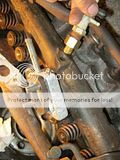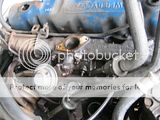Task six is done...JB Weld in the anular part between the 1.75" Holley 1946 base and the 63 heads 1.3" Holley 1909 base. That little sucker consummed w-a-y too long, and the results are just okay, no work of art there. I had to grub screw pin and loctite a barbed/fluted steel PCV port line. And go through about three hours of cutting, bending and hacking the 12mm alloy tooling plate to suit. I liked doing my x-flow LPG adaptor back in 1996 and my 2001 lpg turbo IMPCO/IHI Cologne V6 conversion much more than this little effort. It seams the more complicated, the easier it is to perform. With this 1-bbl Holley, I was starting to think it was beneath me. But it has a smooth transition, and allows me to use any log head from 1960 to 1983. So I can wipe the worries of two week head swaps from my mind.
The adaptor was cut down to this size

Then JB Weld added to fair in the 225 thou annular ledge formed when the 1.75 carb meets the tiny 1.3" early round body head

Task Seven was the 1/8" fittings used for the manifold vac for power brake booster. I used a 1984 Alloy Head vac tree 'tee', and the 1/8 to 1/4" transition piece, and a British 1982 Cortina V6 brake booster line. The 1963 head has no normal vac drilling on the front top of the log.


Task Eight, a similar fittings problem. The 1/8" BSP for the water temperature sensor. The 1981 3.3 water temp sensor is way too big to fit, so I've had to procure another type of 1/8 to 9/16" converter, one that has a big enough internal basin to measure water temperature properly. I looked at the 1960 to 1967 sensors for 144-170-200's ( your US XK200 which we called an XK, XL,XM, XP, and your US 1966 Falcon which we called an XR) and they are all standard US sizes coincident with those years. In 1968 with the XT , Aussie 188/221 logs ran a smaller sensor which remained from then till October 1980 on the 200 and 250 engines. Another similar( but not the same) was made for the Honda Alloy Head engines. All 68 to 92 engines therefore had much smaller 1/2" items.

I used the brake booster line plug to plug up the temperature gage hole

Task Nine is the adjustable 1963-1965 valve train used for hydraulic lifter engines under the stock 1981 rocker cover. Hope theres enough room there, or I'll have to make another adaptor to raise it up to clear the 12 adjusting nuts.

Well, there we have it. I can now fit any head log head on my Mustang, with the kickdown and carb and emissions and sensors all there. Exception is EGR, though it is able to be fitted easily even to a pre 1968 heads since the 1/8" vac port is where one on the 9/16 EGR bolts is, and another adaptor would have it nixed.
My next task is to calibrate the roughness gear I have mounted up, but I had to do the headgasket first, and needed a proper E1 head to gasflow on my P17 flowbench.
Other tasks for me going forward are:-
1) a special Cologne V6 adaptor plate and A4LDe to hook up (this puts the starter away from any tube header or turbo charger, and allows the tiny US C3 200 and Cologne 2.8/2.9/4.0 138 tooth bell housing to be fitted up to any 144/170/188/200/221/250 block, even in the early round body trans tunnel restricted Falcons
2) a special variantion of the
Baldrick style m -series Supercharger kit to organise (this is M114, and needs EDIS)
3) and a low mount nested Lincs 200 style T03 60 turbo kit to fit the 4.5625" spacing foot ball exhast manifold
4) an NC6VHO adaptor to 4.9 F150 EFI unit to calibrate. It follows
73 Green Machine's awesome twin Impco LPG intake manifold on the Classic In-lines head.
5) 4" frame lift and 420 G Diamler Limosine IRS for my Explorer(same Dana 44 diff, same load rating as my 98 Explorer)
These four ingredients are in preporation to getting my FAZER6 engines up an running in the Mustang and Explorer. The Explorer is being used as my tow vehicle, and the Mustang as a certified running in vehcile.
I'll be back every now and then to show progress.













































